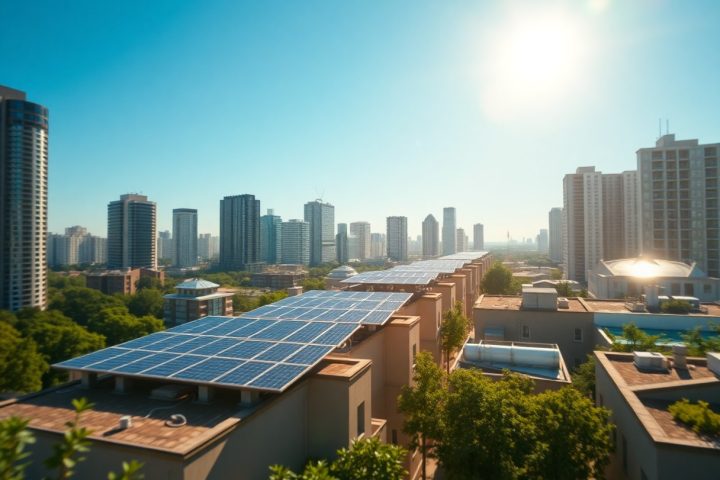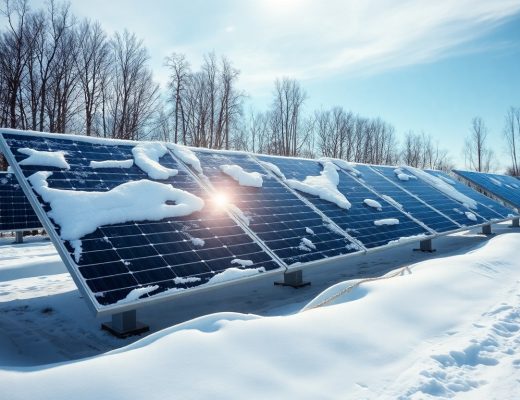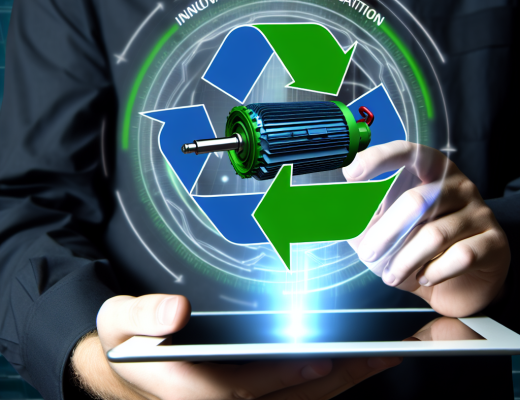Over the past few years, you may have noticed a significant rise in solar energy adoption, particularly in bustling urban areas. This blog post explores into how solar panels function within cities, highlighting their efficiency, installation considerations, and the potential benefits for you, as a city dweller. You’ll discover how these renewable energy systems can be integrated into your lifestyle, reduce your energy bills, and contribute to a more sustainable environment. Join us as we explore the innovative ways solar energy is transforming urban landscapes.
The Basics of Solar Energy
A solar panel system converts sunlight into electricity, providing a clean and renewable energy source. By harnessing the sun’s energy, you can reduce your reliance on conventional fossil fuels and lower your utility bills. The technology has become increasingly accessible, making it an ideal choice for urban dwellers looking to contribute to a sustainable future.
How Solar Panels Function
Along with sunlight, solar panels use photovoltaic cells to convert solar energy into usable electricity. When sunlight strikes these cells, it energizes electrons, generating direct current (DC) electricity. This DC is then converted to alternating current (AC) electricity via an inverter, enabling it to power your home appliances and possibly feed excess energy back into the grid.
Types of Solar Panels for Urban Use
When considering solar panels for urban environments, it’s vital to choose the right type suited for limited space and varied rooftops. Here are three common types:
- Monocrystalline
- Polycrystalline
- Thin-film
Thou can select based on efficiency, installation space, and overall energy needs.
| Type of Panel | Efficiency Rating |
|---|---|
| Monocrystalline | 15-22% |
| Polycrystalline | 13-16% |
| Thin-film | 10-12% |
| Building-Integrated | 10-15% |
| Hybrid Panels | 20-24% |
And as you explore further, consider the specific benefits and applications of each solar panel type. Monocrystalline panels are known for their high efficiency and longevity, making them a popular choice for limited space. Polycrystalline panels tend to be more affordable, while thin-film options offer flexibility and lightweight advantages for varied installations.
- Monocrystalline – High efficiency and space-saving
- Polycrystalline – Cost-effective and lower power output
- Thin-film – Lightweight and flexible for unique installations
Thou can choose which one best fits your urban lifestyle and energy requirements.
| Panel Type | Best For |
|---|---|
| Monocrystalline | Limited Roof Space |
| Polycrystalline | Budget-conscious Systems |
| Thin-film | Custom Installations |
| Building-Integrated | Architectural Aesthetics |
| Hybrid Panels | Maximum Efficiency Needs |
Advantages of Solar Panels in Urban Areas
Any city dweller can appreciate the numerous advantages of integrating solar panels into urban landscapes. From reducing reliance on traditional energy sources to enhancing property value, solar energy presents a sustainable solution that not only benefits your household but the entire community. By harnessing sunlight in densely populated areas, you contribute to cleaner air, lower energy costs, and increased resilience against power outages.
Environmental Benefits
To understand the environmental benefits of solar panels in urban areas, consider how they reduce your carbon footprint. By switching to solar energy, you directly decrease greenhouse gas emissions and support the transition to cleaner energy sources. This not only leads to improved air quality but also enhances urban biodiversity by reducing the ecological impact of conventional energy production methods.
Economic Savings
Behind every solar panel installation lies the potential for significant economic savings for you as a city resident. Not only can solar energy lower your electricity bills, but it can also increase your property value and provide incentives such as tax credits or rebates.
Understanding the economic savings associated with solar panels involves examining both immediate and long-term financial benefits. By generating your electricity, you minimize monthly utility costs, and in many cases, excess energy can be sold back to the grid. Additionally, the installation of solar panels may qualify you for local, state, or federal financial incentives that can drastically reduce upfront costs. As you invest in solar technology, you also position yourself favorably for rising energy costs, ensuring more predictable and stable financial planning for your household.
Challenges of Implementing Solar in Cities
Assuming you are considering solar energy for urban areas, it’s important to recognize the unique challenges that arise. Cities often struggle with integrating solar panels due to factors such as space limitations and regulatory hurdles that can impede installation and efficiency. By understanding these challenges, you can make informed decisions as you explore solar energy options for your urban environment.
Space Limitations
Around urban areas, the availability of suitable installation space for solar panels can be limited. High-density living, competing structures, and shading from neighboring buildings can hinder the effective use of solar technology. You may need to consider alternative solutions, such as community solar projects or solar canopies, to maximize solar energy generation in your area.
Regulatory Hurdles
Any efforts to implement solar panels in cities often face various regulatory challenges that can delay or restrict installation. Local zoning laws, building codes, and permitting processes vary significantly, making it important for you to navigate these regulations carefully when planning your solar energy project.
Considering the regulatory hurdles, you will find that city ordinances can be complex and sometimes contradictory, creating confusion when trying to install solar systems. Municipal requirements may demand specific certifications and inspections, potentially leading to lengthy approval processes. Staying informed about your local regulations and engaging with governing bodies early in the planning process can help you streamline installation and avoid unnecessary delays. Building strong communication with local authorities can also create advocates for solar energy, paving the way for smoother implementations in your community.
Innovative Solutions for Urban Solar Energy
After recognizing the potential for solar energy in urban landscapes, innovative solutions are emerging to help integrate solar technology seamlessly into city life. These advancements not only facilitate the use of renewable energy but also enhance the aesthetic and functional appeal of urban infrastructure. As cities grow denser, finding creative ways to incorporate solar power becomes necessary for sustainable urban living.
Building-Integrated Photovoltaics (BIPV)
Energy-efficient design is at the heart of Building-Integrated Photovoltaics (BIPV), where solar panels are incorporated directly into building materials. This means that rooftops, windows, and facades can generate electricity while serving their primary purpose. By adopting BIPV, you can reduce energy costs and contribute to a greener cityscape, all without sacrificing design or functionality.
Community Solar Projects
Solar energy initiatives in urban settings often include community solar projects that allow multiple households to benefit from shared solar installations. This approach makes it easier for you to utilize renewable energy even if you cannot install solar panels on your property.
Also, community solar projects pave the way for greater accessibility of solar energy, particularly for those in rental housing or low-income communities. By investing in a portion of a larger solar farm, you can receive credits on your electricity bill, thus enjoying the benefits of solar power without the high upfront costs associated with individual installations. Such projects foster community collaboration and advance the collective goal of reducing carbon footprints while providing equitable access to clean energy.
Case Studies of Successful Urban Solar Installations
Despite the challenges of urban environments, several cities have effectively integrated solar energy into their infrastructure. Here are notable case studies showcasing successful solar installations:
- San Diego, California: Over 200 MW of solar capacity installed, with a goal of reaching 100% renewable energy by 2035.
- Los Angeles, California: Nearly 800 MW sourced from solar, powering thousands of homes and reducing greenhouse gas emissions by 36%.
- New York City, New York: The NYC Solar Map allows users to assess solar potential, resulting in a 40% increase in installations over the past five years.
- Chicago, Illinois: Solar on rooftops program initiated; about 100 MW of solar power generated, promoting local job creation.
Leading Cities in Solar Adoption
To understand the landscape of urban solar energy, focus on cities leading the charge in solar adoption. Cities such as San Diego, Los Angeles, and New York are pioneers with robust solar policies and financial incentives that have significantly increased their solar capacity and community engagement.
Lessons Learned from Urban Solar Projects
Among the insights gathered from urban solar initiatives, you will find the importance of strong local policies, community involvement, and innovative financing models that foster increased adoption and sustainability.
Consequently, these lessons serve as a guide for other cities looking to enhance their solar infrastructure. Engaging communities through awareness campaigns, offering financial incentives like tax rebates or grants, and developing adaptable regulations can boost both installation rates and public support. Urban projects demonstrate that overcoming barriers often hinges on collaboration between governmental entities, local organizations, and the community.
Future Trends in Urban Solar Energy
Many experts predict a significant rise in urban solar energy adoption in the coming years. As cities face increasing energy demands and environmental concerns, integrating solar power systems into urban infrastructure will become more prevalent. You can expect advancements in solar technology, along with collaborative efforts between local governments and businesses, to drive the growth of solar energy in urban landscapes. This trend will reshape the way you think about energy consumption and sustainability in your city.
Technological Advancements
Future developments in solar technology will revolutionize urban energy production. You will see more efficient solar panels with improved energy conversion rates, making it possible to harness more sunshine, even in limited rooftop spaces. Innovations like building-integrated photovoltaics and solar skins will allow for seamless integration of solar energy solutions into urban architecture. As a result, your community can generate clean energy without compromising aesthetics.
Policy Changes and Initiatives
An increasing number of cities are adopting policies aimed at encouraging solar energy installation and usage. These initiatives can significantly impact your ability to access solar power. They often include incentives for homeowners, streamlined permitting processes, and financing options that make it easier to invest in solar technology.
Changes in policies regarding solar energy, such as tax credits, rebates, and affordable financing, can dramatically increase your opportunity to adopt solar solutions. Local governments are also implementing stricter building regulations to support solar installations on commercial and residential properties. By keeping you informed of these initiatives, your community can actively participate in the transition towards sustainable energy sources and reduce overall carbon footprints. Through collaboration, these policies are fostering a greener future for urban environments.
Final Words
Drawing together the insights on solar energy in urban environments, you can confidently consider solar panels as a viable solution for your energy needs. By harnessing sunlight, these systems convert solar energy into electricity, significantly reducing your utility bills and carbon footprint. Understanding the practicalities of installation and maintenance allows you to make informed choices that benefit both your household and the environment. As cities continue to embrace sustainable technologies, integrating solar power into your daily life not only enhances your energy independence but also contributes to a greener future for your community.




